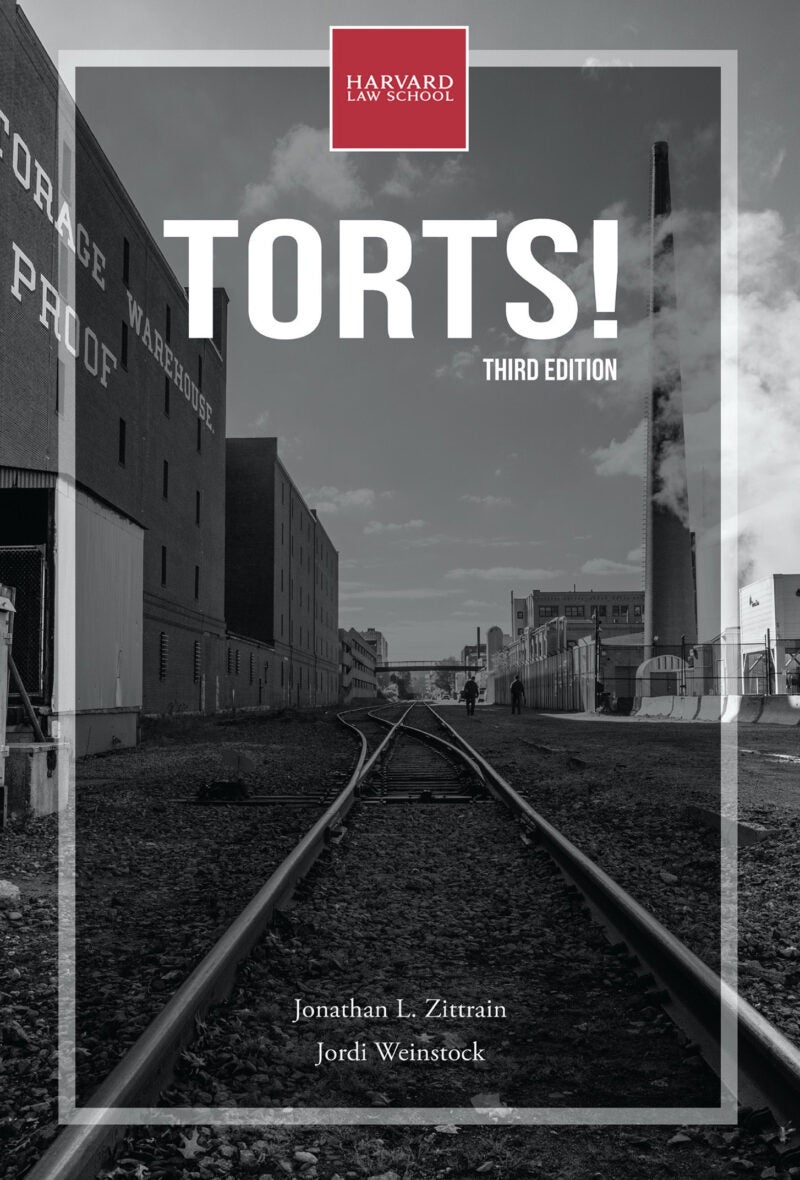The teaching of torts is a cornerstone of a law school education, as studying the cases in which a wrong is addressed by the court remains fundamental to understanding our legal system. With the goal of making such tutelage accessible and available to a greater range of students, this year Torts! — one of the first online open casebooks offered through Harvard’s H2O platform — is now also available in the handy and portable form of, yes, an old-fashioned bound-paper text.


Leveraging the free, comprehensive open-source casebook created by Jonathan Zittrain ’95, the George Bemis Professor of International Law at Harvard Law School, and Jordi Weinstock, lecturer on law at Harvard Law School, the two published Torts! Third Edition in March as the first in the Open Casebook series of high-quality, low-cost text books designed to make these primary texts affordable to law students across the United States launched in partnership with MIT Press.
“The MIT Press is committed to leveraging its role as an academic publisher to increase the impact and accessibility of scholarship,” said Amy Brand, director and publisher, the MIT Press. “We are proud to partner with the Harvard Law School Library on the publication of Torts!, the inaugural book in the Open Casebook Series, and make a high-quality, low-cost textbook more readily available to students throughout the United States.”
The move, explained Zittrain, is designed to complement the free and comprehensive online version accessible accessible on the H2O platform, enabling students “to have a book you can put in your backpack and read in a cafe and bring to class, especially if the class doesn’t allow laptops.”
Noting that too many students were already using printouts of the online casebook, he cited the “bread-and-butter impact” of providing a physical text “that’s reasonably formatted and bound, rather than something held together with a big alligator clip that came off of some poor inkjet printer.”
Torts! was chosen to launch this series for several practical reasons. A required text for first-year law students, Torts! maps the progression of the law of torts through the language and examples of public judicial decisions in a range of cases. As a primary text, it was also among the first books published on the H2O open casebook platform, originally made accessible in 2012. Also, as Zittrain explained, the book had been road-tested.
“We’ve had a chance to update the syllabus year after year,” he said, using the open casebook features to remix the text — “swapping and editing” content. Now maintained by the Library Innovation Lab at the Harvard Law School Library (where Zittrain serves as vice dean for Library and Information Resources) the H2O platform was first developed by Berkman Klein Center for Internet & Society, with support from the Harvard Law School Library. Dedicated to expanding the bounds of open-access legal education, it currently offers more than 350 casebooks and access to more than 6,000 legal documents.
“We wanted to see how the two formats could work together,” said Zittrain. “It also seemed a good idea to have the text for a required first-year class as one of the first books, because those are the books that the students don’t have a choice about buying.”
Although by its nature more limited than the online version, the bound paper version of the book has an advantage over traditional textbooks in that it is modeled on the course as taught by Zittrain and Weinstock. “The traditional textbook has 400 cases. They’re very heavily edited, and you read them disjointedly,” said Weinstock. “You may get a case that has 7,000 words, but you’ll only have 300 words from that case in the book.”
We’re trying to have the best book that we would want to teach. And we hope that other people are interested in using it as well. But we’re also hoping that it inspires them to think critically about the materials they use and to be more flexible.
Jordi Weinstock
By comparison, Torts! offers much more complete versions of the cases that Zittrain and Weinstock teach — in effect a snapshot of their class. And while professors are still invited to utilize the open-source casebook to customize their own classes, those who choose the bound version of the book will find a syllabus already tested at the highest level.
While Torts! covers the canon of tort law — the “30 or so cases that are in every textbook,” according to Weinstock — its authors felt free to be selective. “It focuses the field of study around the topic, not just on a cannon but around the wonderful variations that come up depending on the interests of the teacher and their students,” said Weinstock. As an example, he noted that nuisance law is skipped in Torts! because the pair don’t include it in their class. However, if a professor wanted to include it, the material is available in the online version.
The other advantage of the online open casebook, of course, is that entire cases, along with relevant commentary, are presented. In addition, the online version can be made more easily accessible to vision-impaired students via web accessibility software (aka “screen readers”). Also, its formatting allows for constant updating with new cases and commentary.
“It’s amazing to be talking with colleagues about an interesting case that just came down in Louisiana and to be able to say, ‘Here’s how I introduced it into the syllabus,’ and with three clicks to be able to tweak it while still having the book that’s available for the whole term,” said Weinstock.
Such customization, stressed both teachers, makes the pairing of the online and the paper texts unbeatable. Said Zittrain, “It’s a great way for a faculty member who wants a somewhat updated contemporary curriculum to have one that we are able to incrementally modify.”
“Jonathan has been making change around open legal teaching for over a decade now, so it is fitting that he and Jordi have written the first book in a series that will continue to explore what open casebooks can be,” said Jack Cushman, director of the Library Innovation Lab. “To make a quality print casebook like Torts! available for just $65 while the digital version remains free and open on H2O is something we’re really proud of, and we’re grateful for MIT Press’ partnership in taking this leap with us. Every 1L has to take a torts class, and most torts casebooks on the market cost over $200. We hope this print book and the accompanying digital version can play a part in lowering the cost of casebooks for these students.”
“We’re trying to have the best book that we would want to teach,” said Weinstock. “And we hope that other people are interested in using it as well. But we’re also hoping that it inspires them to think critically about the materials they use and to be more flexible.”
